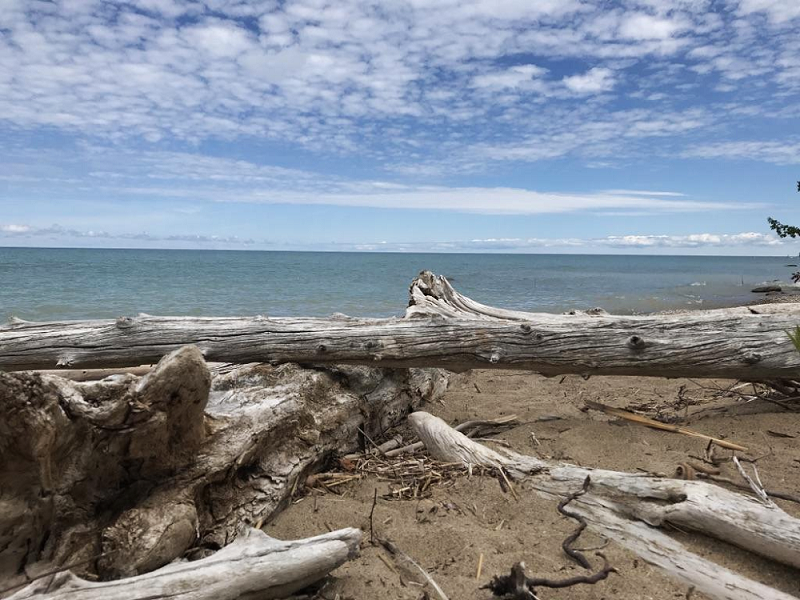
For a while, park staff have been wondering: why do some of our guests who come to visit natural environments feel compelled to leave their mark on that beach, waterfall, or lookout after they’ve left?
At MacGregor Point Provincial Park, we’ve noticed some changes being made to our shorelines by well-meaning sun-seekers who visit our beach for a short time, but leave behind structures made of driftwood.
Staff in our park and others have disassembled several driftwood forts upon discovering them on our beaches, which can be a dangerous task.
Let’s talk about why we’d prefer our visitors to leave driftwood where it lies, and some fun things you can do at the beach instead of building forts.
~
Don’t harm a habitat
You may wonder what the big deal is, and why park staff would care at all about forts made of driftwood on our beaches.

Of course, we are much more bothered by the sight of litter left behind on our beaches than natural objects like driftwood.
But in the case of driftwood forts, our beach visitors are simply not aware of the harm that can be done by creating these structures on a beach that previously resembled natural shoreline habitat.
Besides damaging habitat, these structures can be very dangerous and time-consuming for staff to remove.
~
Save the shorebirds; leave it where it lies
Driftwood has not yet finished its journey when it washes up on the shores of our parks.

If the driftwood is left to lie where it washes up, insects, arthropods, larvae, salamanders, and other critters move in and use the driftwood as a home as well as a food source.
Shorebirds, which face many threats due to changes to their habitats, can be seen on beaches eating the bugs and grubs which live inside driftwood.
They also use driftwood to hide from predators and protect their nests.

Some of these shorebirds will only nest on healthy beaches that have enough driftwood and plants for cover.
This type of habitat provides significantly more protection and safety for raising a family than an empty sandy beach with a few decorative driftwood forts left standing.
A beach that lacks driftwood also lacks natural hiding places, making shorebird nests much more vulnerable to predators such as foxes, gulls, cats, and raccoons.
~
Shaping healthy shorelines
Besides shelter and food, driftwood also provides much needed stability to beach environments.

Driftwood is an important and free line of defense against wave erosion, which is vital as water levels rise. By leaving driftwood where it lies, eroding portions of our beaches can be stabilized and restored over time.
This means that a few pieces of driftwood can actually shape the shoreline and create new habitat for a large community of flora and fauna. So although it may appear to be the perfect material for building forts, it’s much more valuable to those who need it to survive.

Leaving driftwood where it lies benefits birds, plants, reptiles, humans, and ultimately the ecological integrity of our parks.
In order to protect sensitive ecosystems, it is not permitted to remove, burn, or create structures out of driftwood in Ontario Parks.
Learn more about why driftwood matters here.
~
Considering building a structure?
Ask yourself why we feel compelled to build structures or towers out of natural objects when visiting beautiful wild spaces.
Making things with your hands can be a meaningful way to connect to nature, however there are lots of ways to do this that do not decrease the functionality of that habitat.

If creating something does enhance your experience of our parks, we encourage you to seek out lower-impact activities that do not require moving or removing structural elements of an ecosystem.
Here are some fun things to do at the beach that do not reduce the survivability of beach habitat for the wildlife who live here:
- building sand castles
- taking photos
- swimming
- sculpting with sand
- exercising
- sun tanning or reading
- birding
- paddling the shores in your canoe or kayak
Great Lakes shorelines can support much more biodiversity when allowed to naturalize.
~
Keep wild spaces wild
To help us in our mission of protecting these spaces, and to help keep our staff safe, we ask that you consider the benefits of leaving driftwood where it lies.

Please help us keep wild spaces wild by leaving no trace.
We want everybody who visits these spaces in the future to be able to experience and enjoy the natural wonders of our parks.

And if you feel compelled to build, ask yourself: how many critters may have given up their homes just so that one person could leave their mark on the beach?
We know you’ll agree: it’s just not worth it.


